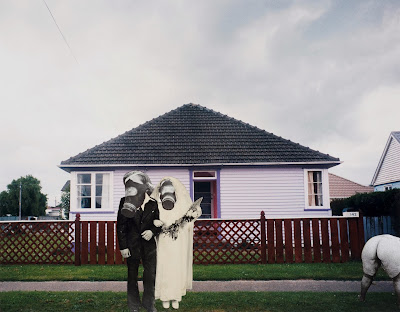"History" painting is rare in New Zealand and always has been. Not so with photography which always has history inserted into its own reality, even if it is consciously avoided. What Mark does is capture history as a visual tracery of the past. He travels to places that have substantive human history.
Very many places have such a significant history for our culture's reality. There's an old trope used about New Zealand that critiques its newness as a country appearing to have a short past. Such as believing there's no history here. Just look around, we may not recognise our visual archaeology of place but it is forever present.
These two photographs complicate this issue of where time sits even more, they are looking at another artist looking, but in the past. In this case it is the art of the Reverend Dr John Kinder. These two images are included in Kinder's Presence, which is currently on show.
Mark has gone to two sites that Kinder himself made famous through his watercolours of the same location painted over more than a century ago.
In his photograph Outlet of Lake Rotokakahi, Mark turns his back on the view which Kinder made of Rotokakahi. 1866. Outlet of Lake 1866 and looks back from what the painter would have been recording when he visited the Thermal regions in the mid 1860s.
What we see in Mark's shot is the road's path into the view that Kinder was making. In his image Te Wairoa, The Buried Village, he carefully attempts to replicate the place that John Kinder stood at to make his watercolour view The Wairoa near Lake Tarawera with Mission Chapel of Te Mu January 4 1866 circa 1886. At left is the stone pataka for storing food.
In Mark's multi-part panoramas the company of time is even more obvious. In After William Hodges' 'Cascade Cove', 21 May 1995 2005 he commemorates the visit of Lt Pickersgill with three companions to the waterfall at Cascade Cove in Dusky Sound on 23 April 1773.
Made famous by William Hodges's painted view of the same waterfall, this place is one of the few sites that one could now visit and see it essentially the same as it looked to Cook's men. How many other of 'Cook's Sites' are still able to be seen as they were? Oddly, there are very few photographs of this actual location available on-line, one has to visit it to get a true sense of its sublime qualities; the very same awe-inspiring feeling that caught Hodges's imagination.
Yet, when one surveys the four parts of Mark's panorama you see how difficult this photograph was to make with large format photographic equipment. It would be a challenging task at any time, let alone in the middle of the winter of 2005. To move from one image to another requires the camera to be adjusted with planned acuity, which is why the panorama has to be fitted together like image building-blocks.
Mark Adams's approach to time is also evident in his 1978 portrait of Tony Fomison's home in Gunson Street, Ponsonby, Auckland. Tony lived in a late nineteenth century kauri villa, whose kitchen/dining area was decorated as if it remained from the time when this house was new. Tony called it the parlour and it was filled with the naive paintings that he assiduously sought from places like Dominion Road's emporium named Antique Alley. The parlour had many visitors and wasn't like the front room kept for best.
Tony's decorating style mimicked and cherished Victorian notions of walls stacked to the brim with pictures and nick-nacks; which would then be left on the walls for decades. This tableau is the faux-past and is done with more aplomb than anything I have seen in any publicly owned local historic house. Mark sees how Tony pricked time in that Grab-the-day-way (a better translation than Seize) of Carpe Diem.
Tony really liked to tastefully flout taste as an art political act. In doing so he got way closer to truths about things. Mark's image could have been a carefully-won shot of a local identity's private interior, but he preferred to create a portrait of his friend Tony through an archaeological record of his mate's parlour at night.
Is it a portrait of Gothic local? Too right and now only existent in this image gifted by the artist and the partners of Ernst & Young. Style and time are always best kept in the tightest of tension. To paraphrase Mario Praz.
Image credits:
Outlet of Lake Rotokakahi
silver gelatin print, toned
courtesy of Mark Adams
Te Wairoa, The Buried Village
silver gelatin print, toned
courtesy of Mark Adams
After William Hodges' 'Cascade Cove', 21 May 1995
gelatin silver prints, toned
Auckland Art Gallery Toi o Tamaki,
purchased 2005
courtesy of Mark Adams
gift of the Deane Endowment Trust, 2005
Note: I am grateful to Sir Roderick Deane and Gillian, Lady Deane for their close support in the acquisition of this Mark Adams panoramic photograph. I considered it to be an essential addition to the Gallery collection and the Deane Endowment Trust generously purchased the artwork and presented it to the Gallery.
Parlour at Gunson Street, Ponsonby 1977 1995
gelatin silver prints, toned
Auckland Art Gallery Toi o Tamaki,
gift of Mark Adams and the Partners of Ernst & Young, 1995























'+2013.11.15+14+PRESS.jpg)


'+2013.11+PRESS.jpg)




